How to Find the Best Historical Places in Pakistan

Despite only being a country for less than 80 years – Pakistan’s rich history goes back thousands of years.
Over the centuries, Pakistani’s multi-cultural past is as complicated as any nation that encompasses a dizzying array of ethnic groups, religions, and languages. When Pakistan broke off from India in 1947 – the lines that were drawn are still a point of contention between the two countries.
The sheer diversity found in the history of Pakistan’s inhabitants means that for people living today – there is an incredible cultural, religious, and ethnic legacy to discover here. Which means for history lovers – Pakistan is a paradise!
Being as that I am a big fan of history (and if I am honest the extremes of history and human experience) – there is a lot more than the big mountains of Pakistan for adventure travelers to get down on.
Plus my father was a high school and university history professor so I had to at least extend his legacy of loving history into this article :).
This is the ultimate guide to the best historical places in Pakistan. Make yourself a coffee, and settle in…
Sunehri Masjid
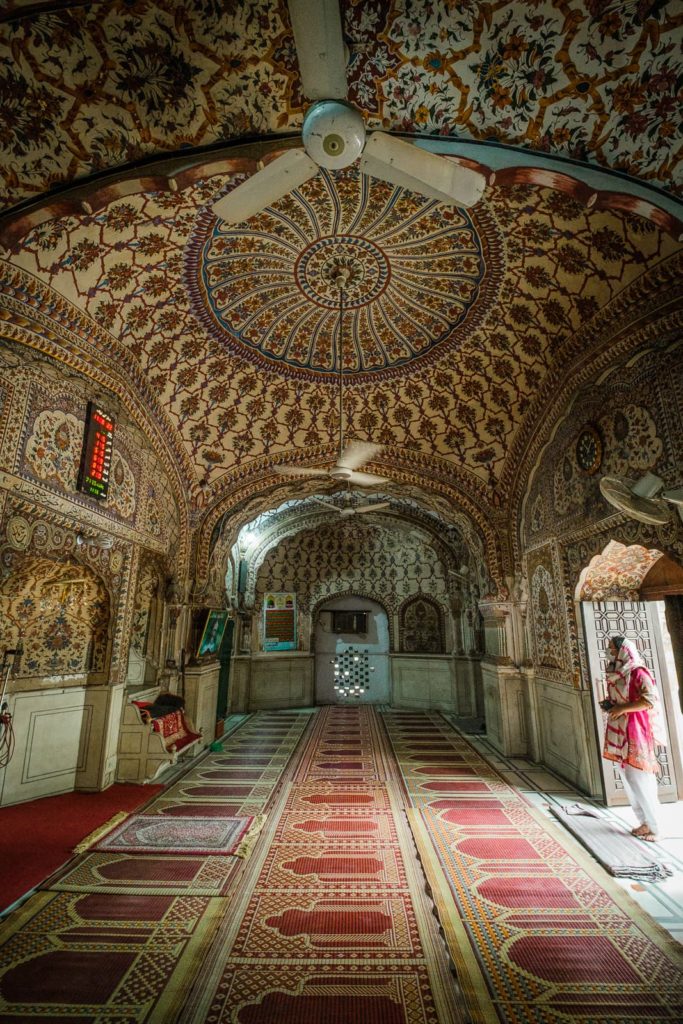
One of the reasons I love Lahore is this: seemingly everywhere you look there are interesting old structures hidden off of tiny unassuming side streets.
One recent gem I stumbled across is Sunehri Mosque (Sunehri = Golden in Urdu) located in Old Lahore.
When I went there the mosque was in the process of being restored. Many of the original tiles and architectural details are well preserved and I am sure it will look even nicer once the entire compound is restored.
I recommend hitting this mosque up on foot if you are walking from Anarkali Bazaar to Food Street. Being that the mosque is kind of hidden – nobody apart from local people actually visits this place – making it one of the best-kept historical site secrets in Lahore.
Entrance Fee: free
Best time to visit: All year
Rohtas Fort
Tucked away off of a dusty road between Lahore and Islamabad – Rhotas Fort is one of the best-preserved Mughal-era forts in Punjab. The site is near the city of Jhelum and can be a bit tricky to reach if you don’t have your own car.
I have been to Rohtas twice and I can honestly say that it is one of the best historical places to visit in Pakistan if you like forts.
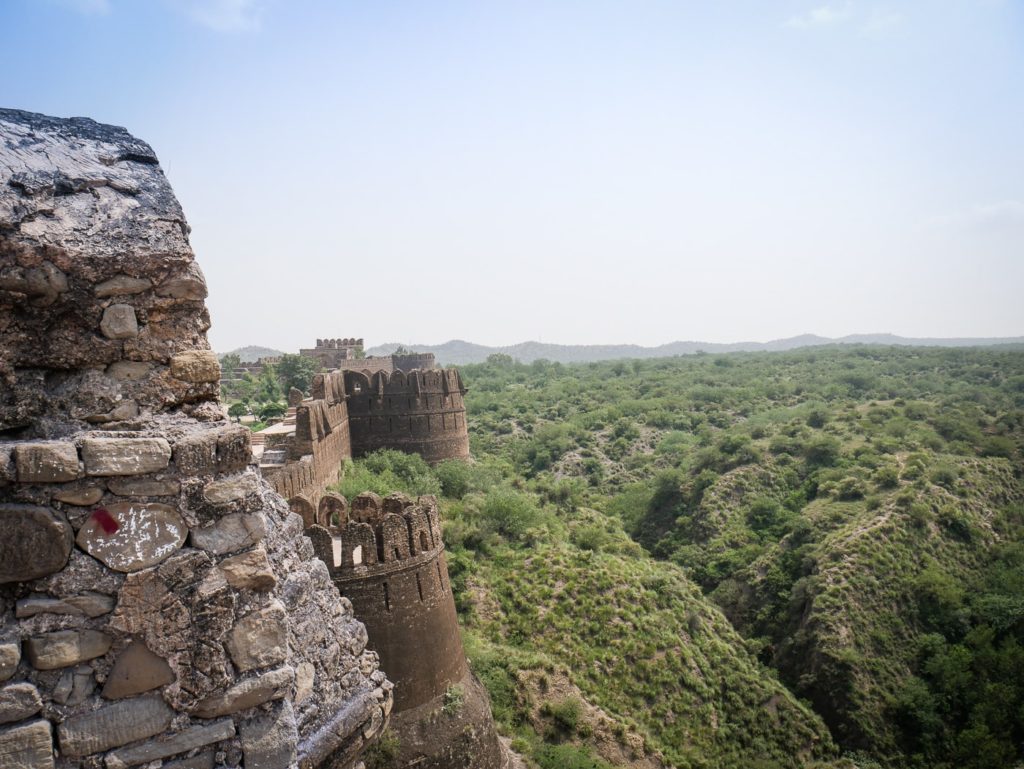
The fortress was built by Raja Todar Mal on the orders of Sher Shah Suri, partly to suppress the local Gakhar tribes of what was then the Potohar region. Some Gakhar tribes were allies of the Mughal Empire, and refused to recognize the suzerainty of Sher Shah Suri.
The fort is known for its large defensive walls, and several monumental gateways. Rohtas Fort was declared a UNESCO World Heritage Site in 1997, as an “exceptional example of the Muslim military architecture of Central and South Asia.”
Note that for much of the year – the temperatures at Rohtas are HOT. I have been in September and in May and both times it was over 40 degrees. Bring lots of water!
Entrance Fee: 500 RS/ foreigner & 20 RS/local.
Best time to visit: early spring or late fall.
Buddha Rock – Skardu
Prior to much of what is now Northern Pakistan coming under Islamic influence, the Baltistan region where Skardu now is was a Buddhist area for the most part. Influences between Balti and Tibetan cultures are felt with the similarity of the two languages and some cultural customs.

One of the best-preserved Buddhist relics in the country can be found just a few kilometers away from the main Skardu bazaar – Buddha Rock.
There is not much else to see here other than the rock but it is a cool spot to visit for 20 minutes or so.
Entrance Fee: 300 RS/ foreigner
Best time to visit: March – November
Swat Valley Monasteries and Buddhist Shrines
The Swat Valley in KPK province has many Buddhist carvings and stupas, and Jeha Nabad contains a Seated Buddha statue.
Kushan-era Buddhist stupas and statues in Swat valley were demolished by the foreign-funded Taliban and after two attempts by them, and the Jehanabad Buddha’s face was destroyed by dynamite. While some old shrines have been destroyed by the former occupants – but there are still quite a few that remain as well.

Gumbatona Stupa in Swat is one of the most important remaining Buddhist relics and a rare example of a true domed Stupa – from the 1st or 2nd century AD.
Makli Necropolis
If you want to see one of the largest burial sites in the world – the Makali Necropolis is the best historical site in Pakistan from that perspective. Spread over an area of 10 kilometers near the city of Thatta, in the Pakistani province of Sindh, this site is home to between 500,000 and a million tombs – which were built over a 400 year period.
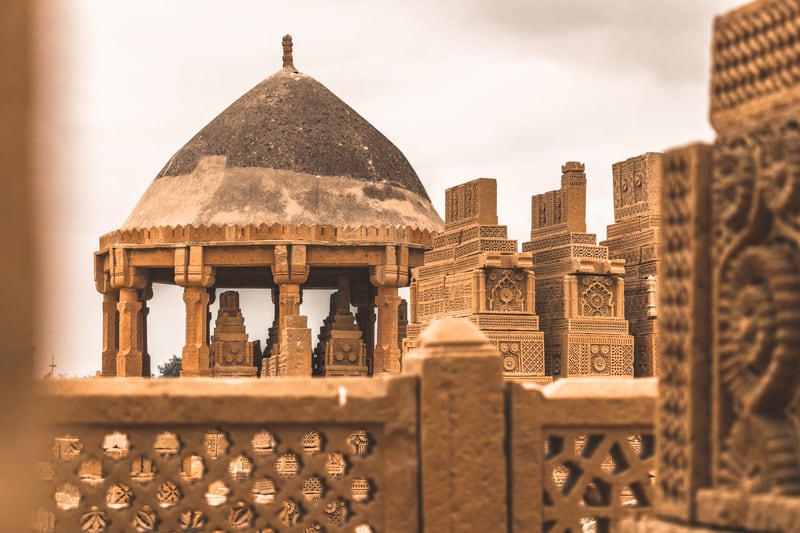
The tombs house former saints, royalty, scholars, clerics, soldiers, and seemingly all of the important people from this region and time period. The site was inscribed as a UNESCO World Heritage Site in 1981 as an “outstanding testament” to Sindhi civilization between the 14th and 18th centuries.
Like all places in Sindh, the summer temperatures here are difficult to handle even for the most heat-resistant traveler. Come in the winter if possible.
Entrance Fee: 1000 RS/ foreigner – 150 rs/ local
Best time to visit: December – February
Karpacho Fort
It actually took me a half dozen visits to Skardu before I finally managed to visit Karpacho Fort in Skardu. Perched atop of steep hill overlooking the valley and river below, the Karpacho Fort is not to be missed – especially if you are interested in snapping some photos of the sunset from a great viewpoint.
The Karpacho Fort site is a mix of ruins and preserved structures and is large enough to spend a few hours at if you have a free afternoon. The old man who is the fort guardian is also very kind and it is not uncommon to see him sipping tea with his friends at the entrance.
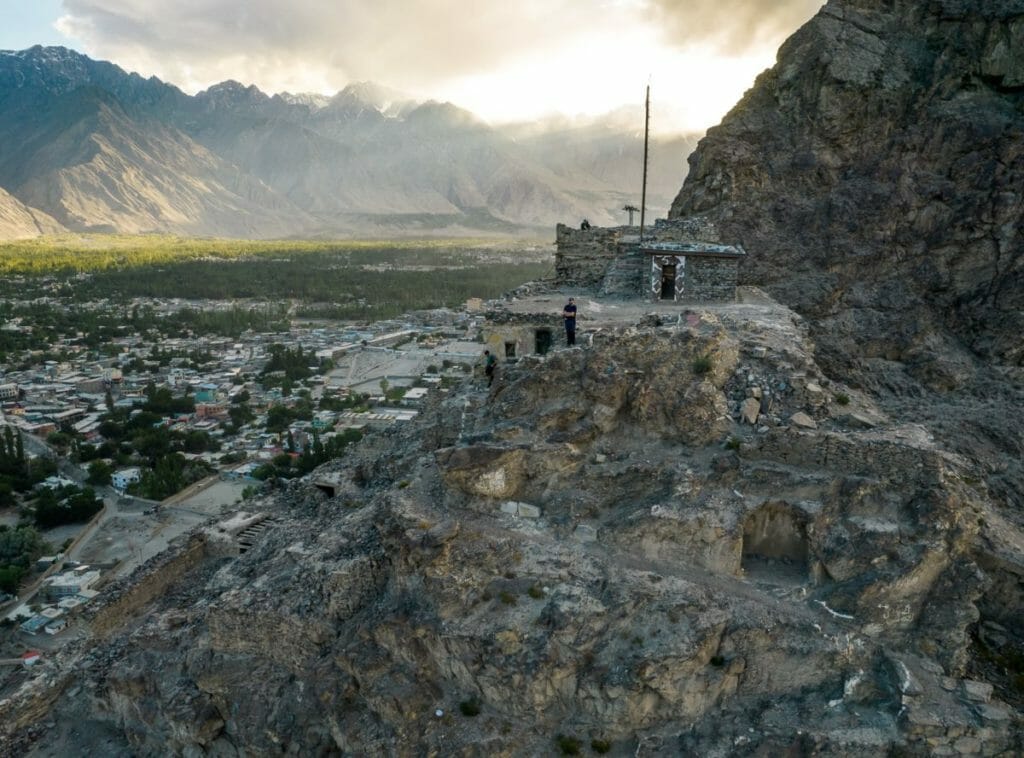
There is no road up to the fort so you’ll need to hike up there directly from the Skardu Bazaar. The road is signed and the trail is easy to follow. It takes most people about an hour to hike there from the Skardu Bazaar street.
Entrance Fee: 300 RS/ foreigner
Best time to visit: March – November
Altit and Baltit Forts
The Hunza Valley is home to two impressive forts: Altit and Baltit. As the former residences of the Kings of Hunza for many generations – both forts offer insights into how the royal families lived. The last King of Hunza actually lived here as recently as the 1930s.
Altit Fort and in particular the Shikari tower is around 1100 years old, which makes it the oldest monument in Gilgit-Baltistan. The fort has received the UNESCO Asia Pacific Heritage Award for Cultural Heritage Conservation in 2011.
In the 1990s Altit and Baltit forts received more than a million euros for restoration after falling into disrepair for decades. They are now among the best historical places in Pakistan and certainly in all of Hunza.

After the British occupation of India, the British garrison which had an outpost in Hunza used the Altit Fort as their HQ – installing the first-ever phone in the valley.
Altit Fort is my favorite of the two and I think that is due to the fact that Karimabad (where Baltit Fort is located) has become a little too touristy for my liking.
The views above the river from Altit are also stunning.
Entrance Fee: 1100 RS/ foreigner
Best time to visit: March – November
Badshahi Mosque

Easily the most recognizable Mosque in Pakistan – the Badshahi Mosque in Lahore is also one of the largest in the world (at one time it was the largest!).
The Badshahi Mosque was constructed by the Mughal emperor Aurangzeb between 1671 and 1673 and was the largest mosque in the world from 1673 to 1986. The mosque is an important example of Mughal architecture, with an exterior that is decorated with carved red sandstone with marble inlay. It remains the largest mosque of the Mughal era and is the third-largest mosque in Pakistan currently.
After the fall of the Mughal Empire, the mosque was used as a garrison by the British Empire and is now one of Pakistan’s most iconic sights.
Pretty much every “things to do” list for Lahore will mention Badshahi – and it can have a bit of a touristy vibe at times. I recommend visiting it once and catching dinner at one of the new Food Street rooftop restaurants like Haveli where you can have awesome views of the mosque while you eat.
Entrance Fee: 50 r/s for “shoe keeping” charge. Free entrance.
Best time to visit: All year (summer is super hot though!)
Mahabat Khan Mosque in Peshawar
Peshawar is just a cool city – and one that is often overlooked. If you have time – don’t miss Peshawar as it has a lot to offer from food to historical mosques to kind people. My favorite mosque in Peshawar:
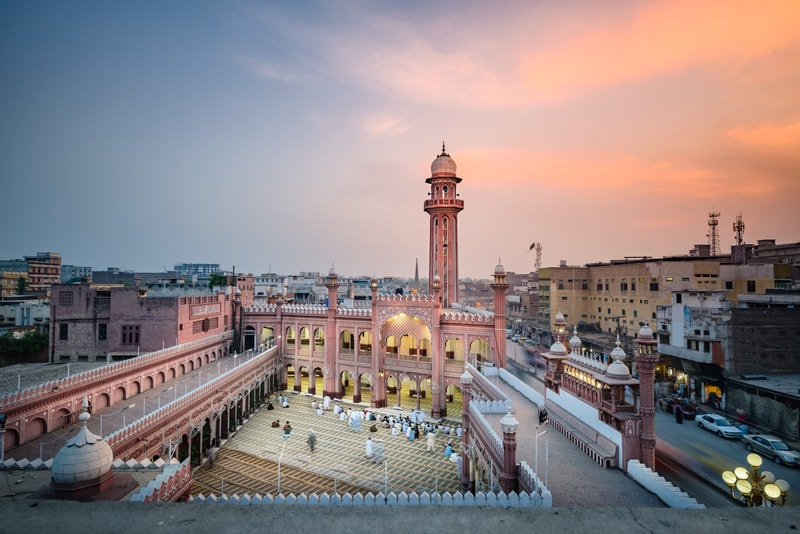
The Mahabat Khan Mosque sometimes spelled Mohabbat Khan Mosque, is a 17th-century Mughal-era mosque in Peshawar, Pakistan. The mosque was built in 1630 and named after the Mughal governor of Peshawar, Nawab Mahabat Khan bin Ali Mardan Khan, known alternatively as Mahabat Khan and Ali Mardan Khan. The mosque’s white marble facade is considered to be one of Peshawar’s most epic sights.
Entrance Fee: Free
Best time to visit: Anytime but summer (June – August are very hot)
Rawalpindi Havelis
If you don’t know what you are looking for, you might miss the old Haveli buildings scattered throughout the famous Raja Bazaar in Rawalpindi. The word haveli is derived from Arabic hawali, meaning “partition” or “private space”, popularised under the Mughal Empire, and was devoid of any architectural affiliations.
Later, the word haveli came to be used as a generic term for various styles of regional mansions, manor houses, townhouses, and temples found in the Indian subcontinent including Pakistan. Haveli hunting is among one of my fav activities when exploring Pakistani cities in Punjab.
The fine old woodwork, unique layout, and elaborately decorated terraces really make these haveli’s in Rawalpindi worth checking out. I recommend exploring Raja Bazaar with a local person who can point you in the direction of some cool haveli houses.
Entrance Fee: Free
Best time to visit: All year (summer is super hot though!)
Wazir Khan Mosque
After Badshahi, Wazir Khan is probably the 2nd most-visited mosque in Lahore. This mosque sits off of a bustling street in the Delhi Gate area of Old Lahore. Busy market stalls selling everything from ladies’ dresses to fresh beef to cooking implements can be found all around the outside of the mosque.
The colored original tiles and minarets make Wazir Khan one of the most impressive mosques I have ever seen.

It is even possible to climb the minarets for an epic view of the Old City and mosque compound. However, the “keeper of the mosque” guy that watches over things won’t always let people up which is annoying. Usually, he asks for a 1000 rs bribe to go to the top, and if it is Friday prayer time – no way he will allow you to go.
I even flew my drone above the mosque – which I also had to pay the mosque keeper for.
Entrance Fee: Free
Best time to visit: All year (summer is super hot though!)
Rani Ghat
Rani Gatt (lit. the queen of stones in a Pashto) is a 2500-year-old Buddhist archaeological site belonging to the Gandahara civilization located in district Buner of Khyber Pakhtunkhwa, Pakistan.
Raniagut is good evidence of the Buddhist past of the area. The site is located on top of a hill, accessible by climbing the stairs constructed by the Japanese. The main attractions include; Stupas, a big rock erected by the ancient people at some distance that they probably used to worship. Thanks Haris Ali Shah for the tip on this one!
Entrance Fee: Free
Best time to visit: All year
Uuch Sharif
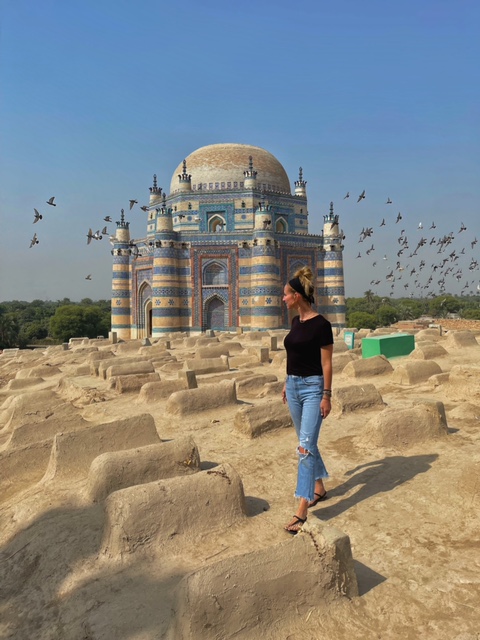
This gem of southern Punjab province is overflowing with ancient history, stunning architecture, and for me personally, is a site that looks like it’s straight out of a storybook to the point that I find it hard to believe that this is a real place.
Uuch Sharif’s history stretches back thousands of years, probably having been founded by Alexander the Great and maintaining status as an important location well into the Islamic period and into modern times. Even today, visitors experience a well-preserved region that is beyond captivating to behold, so people looking for something truly special shouldn’t pass this up.
Entrance Fee: Free
Best time to visit: Early spring and fall
Mohenjo-Daro
One of the most prominent archeological sites in the world, Mohenjo-Daro is also one of the world’s most ancient cities, founded by the mysterious Indus Valley civilization. This is a UNESCO World Heritage Site and is a highlight not only of Sindh province but in all of Pakistan.
For being so old, Mohenjo-Daro is well-preserved, but this jewel of the ancient world is under constant threat by erosion. Responsible visits to one of the world’s first examples of a major city are encouraged to be taken soon, as there is the constant risk of the character of this site being changed – or damaged – forever.
Entrance Fee: 1000 RS/ foreigner – 150 rs/ local
Best time to visit: Spring – fall
Bahawalpur

Located in Punjab province, Bahawalpur is a dream, with history stretching back centuries and ancient structures built in exquisite detail. This city is for lovers of history, flavorful food, and eye-popping architecture.
Not only is Bahawalpur an oasis of culture, it is also nearby Lal Suhunra National Park, one of the largest national parks in South Asia. That makes this town virtually the complete experience for anyone’s wants in a destination, whether it’s learning more about the region’s past, soaking in natural beauty, and more.
Bahawalpur can get suffocatingly hot in summer, especially for those not used to high temperatures (it can even be a struggle for locals, too), so it’s best to spend time in this city during the cooler months of the year.
Entrance Fee: Free
Best time to visit: Late fall and early spring
Tomb of Jahangir
Not far from the ancient Walled City of Lahore, this tomb is a can’t-miss historical landmark and one of the most elegant examples of Mughal architecture there is to be found in all of Pakistan. Anyone fascinated by peculiar, unique history will find exploring this site a remarkable experience.
Although the history of the site itself is a bit hazy, with differing accounts attributing construction to different people, this Mughal emperor’s tomb is, to this day, unbelievably well-preserved for casual visitors and serious students of history alike to soak in.
Entrance Fee: Free
Best time to visit: Late fall and winter
Former Compound of Osama Bin Laden – Abbottabad
If you made it this far down my list – you needed a little spark to make you do a double-take. Made ya look!
Many people have asked me if it is possible to visit the former compound of Osama Bin Laden and his entourage. I am here to tell you that it is 100% NOT POSSIBLE. The Pakistani government had it demolished shortly after Bin Laden was killed by US Navy Seals to avoid it becoming a dark tourism/pilgrimage site. Trust me, there are much more interesting sites in Pakistan than chasing a compound that does not exist anymore.
Best Historical Places in Pakistan – Final Thoughts
There you have it amigos – you are now armed with the best historical places in Pakistan.
From a time perspective the nation of Pakistan is very new – but from a historical vantage point – the country is full of a seemingly endless of array of diverse historical attractions dating back centuries (and beyond).
Thanks for taking the time to check out this epic list. If you have been to an epic historical place in Pakistan that I did not mention, drop the name in the comments below so I can add it to the list (if it is up to scratch).


Pakistan is a culturally diverse country with natural beauty, culture, cuisine, and, of course, historical sites. Pakistan offers it everything, from lush green plains to enormous mountain ranges and stunning deserts. People who enjoy visiting antique and historical sites would find Pakistan to be a wonderland. Various civilizations reigned over the nation. Throughout their excursions, several renowned persons travelled through the land. People from around the world travel to visit these historical places in Pakistan and enjoy these.
Agreed! Super diverse place. One of the reasons why I love the country :).
Pakistan is truly underrated. So much to see and explore. Thanks for sharing this.
Cheers! Glad you enjoyed the blog!